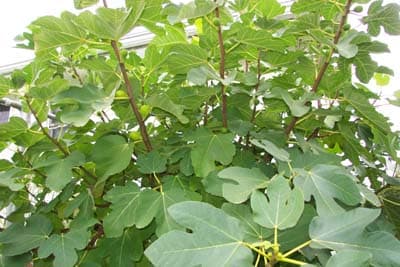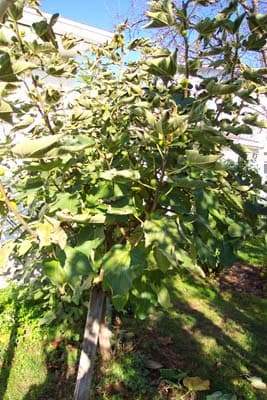How to Grow Fig Trees

About Growing Mediterranean Fig Trees in Your Yard
Figs are an interesting fruit to grow. Perhaps not as popular as an apple tree, fig trees are low maintenance. And they produce an abundance of fruit. They are related to Mulberry bushes. And they are native to the Mediterranean and Asia. Fig trees prefer warmer climates, with a long growing season. However, you can succeed in growing fig trees in more northerly areas. Some varieties exist for growing in cooler areas. The key to success is to provide a little protection to your trees, in both the spring and the fall. Also, winter protection is important in northerly regions.
You can grow dwarf varieties on your patio or deck. Also, with sufficient light, they will grow indoors in containers.
Did You Know? The lifespan of a fig tree is 150 – 200 years. So, you can plant a tree and it will produce fruit your whole life.
Fig Tree Plant Specifications
Flowers Bloom: Late spring to early summer.
Days to Harvest: 60 to 90 days from flowers blooming. Timeframe varies, depending upon variety.
Fruit Ripens: Late summer to Fall.
Tree Height: Standard trees grow 10 to 30 feet tall, depending upon variety. Dwarf Fig trees grow 4 to 10 feet tall.
Light Requirement: Full sunlight.
Ideal Soil pH: 6.0 – 7.5.
Plant Hardiness Zones: Grow cool weather varieties in zones 5 to 7. Plant warm weather varieties in zones 8 to 10. Long-lived trees, 150 to 200 years.
Number of Species: 850
Native To: Asia and Europe.
Botanical Name: Ficus carica
Light Requirement
Select a planting location that offers full, bright sunlight. They need at least 7 to 8 hours of full sunlight. In hotter regions, they benefit from a little afternoon shade. However, insufficient sunlight affects crop production.
You can grow fig trees indoors, too. Place them in a home greenhouse, an enclosed arboretum with a glass roof, or a sunny southern window. Be cognizant of the amount of sunlight they receive. Adds a grow light over them, if existing sunlight is insufficient.
Fig Tree Propagation
Fig trees are grown from seed. It takes three or four years to go from the seedling stage to a fruit-producing tree. Most people don’t want to wait that long. Even though figs are easy to grow, they are not a popular, home-grown fruit tree. Your local garden nursery may have young trees in stock. Or, they may not. You can always purchase them online.
Planting a Fig Tree
Select a location in your yard that receives full sun. Dig a deep hole. Add plenty of decomposed compost, if available. Mix thoroughly with regular garden soil. If the tree you have bought is inside of a peat pot, leave it in the container. It is helpful (but not required) to slit the container to allow roots to more easily exit the container. While making the slits, be careful not to cut the roots, as you can do more harm than good. If your tree is in a burlap bag, remove the bag. Gently spread the roots in the hole you have dug.
Bury the plant up to where it was in the container. Soak the soil thoroughly. Add more soil if needed.
When planting trees in more northerly climates, select the sunny (south) side of your house or shed. This will allow warmer temperatures, in spring and fall, and extend the growing season.

How to Grow Fig Trees
Plant new trees in full sun. Once your new fig tree is planted, it should grow quickly.
Fig trees require little care and maintenance during the season. Insect and plant disease problems are uncommon. So, you do not need to spray them. Animals seldom eat them either.
Tip: Fruit tree fertilizer spikes are a great way to boost the growth of your new tree. The spike slowly releases a fertilizer specifically formulated for fruit trees.
It takes three to four years for the trees to become mature. The trees begin to produce fruit when they are mature.
The size and number of fruit are dependent upon several things. As a rule of thumb, more figs on a tree, resulting in smaller individual fruit. Sometimes, mother nature pollinates a profusion of blooms. Sometimes frost nips a portion of the blooms. Removing a few of the baby figs will make the remainder grow bigger.
Protect the trees from strong wind.
Harvest fruit after it turns completely ripe. Signs of ripeness are soft and dry feeling fruit.
Harvesting Figs
Harvest fruit after it turns completely ripe. Signs of ripeness, are soft and dry feeling fruit.
Storing Figs
When the harvest begins, you will quickly reap more than you can eat. Without a doubt, you will begin to cook with them, and perhaps make jam and jelly. Your harvest likely will still leave you with more figs than you can immediately use. There are several ways to store figs to extend their shelf life.
As a first step, examine each piece of fruit that you bring into the house. Discard any overripe or damaged fruit. Your composter is a good place to dispose of them. Next, store them in any of the following ways:
Fresh on the counter -As soon as the harvest begins, load up the fruit bowl. Keep them out of direct sunlight. On the counter, they last two or three days. However, chances are you and your family will eat them before long.
In a box or on a tray – Place the fruit in a single layer. Place paper towels between each fig. This way, if one goes bad, it won’t affect the neighboring fruit. Check them every day or two. If possible, put the tray in a cooler location. They will last a few days longer than on the kitchen counter.
Place them in the refrigerator – Place them in a breathable container. Do not use plastic storage containers with a lid. Place the container in the vegetable crisper. The figs will last a week to ten days.
Flash Freeze – Freeze them individually, not touching each other. Put them in a freezer bag. They store up to a year.
Dried Figs – First, cut them into pieces. Then, dry them in a dehydrator or in the oven.
Pruning Fig Trees
Like other plants, pruning established trees is healthy for them. It results in a bigger crop. Prune the trees in the fall, after the first frost. Plants can be cut way back, to encourage new growth, and keep the size of the tree manageable.
Winter Care and Maintenance
In warm, southerly areas: No special care is needed. Just trim the tree back, if desired, and wait until next spring.
In colder, northerly areas: Trees can die in cold winters. Cut the tree back and provide winter cover. Some people wrap the entire tree and fill the wrap with insulating materials. Materials can include straw, old rugs, clothing, balled-up appears, etc. Smaller trees can be carefully bent down towards the ground, then covered up.
Fig Recipes
Here’s a great recipe to try when your fruit ripens. And, don’t forget to make it during the holidays.
Related Articles
Also, people who read this article will like:
Please support our site. Shop for:
- rmmatthews100@hotmail.com
- 585-721-6528
- Rochester, NY
©1999-2024 GardenersNet.Com, All Rights Reserved

